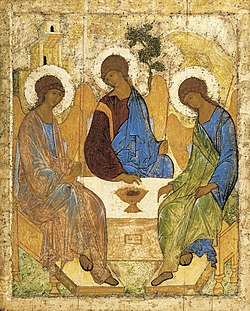Top Qs
Timeline
Chat
Perspective
January 29 (Eastern Orthodox liturgics)
Day in the Eastern Orthodox liturgical calendar From Wikipedia, the free encyclopedia
Remove ads
January 28 - Eastern Orthodox liturgical calendar - January 30

All fixed commemorations below are observed on February 11 by Eastern Orthodox Churches on the Old Calendar.[note 1]
For January 29th, Orthodox Churches on the Old Calendar commemorate the Saints listed on January 16.
Saints
- Martyr Chryse (ca. 41-54)[1]
- Martyrs Sarbelus (Thathuil) and his sister Bebaia, of Edessa (110)[2][3][4][5][note 2]
- Saint Barsimaeus the Confessor, Hieromartyr Bishop of Edessa (114)[4][7][note 3]
- The Holy Seven Martyrs of Samosata (297):
Remove ads
Pre-Schism Western saints
- Saint Caesarius, a deacon in Angoulême in France under its first bishop St Ausonius (1st century)[17]
- Hieromartyr Constantius of Perugia, first Bishop of Perugia, and Companions (170)[6][17][18][note 6]
- Martyr Sabinian of Troyes (275)[6][17][19]
- Martyrs Papias and Maurus, soldiers martyred in Rome under Maximian (ca. 303)[17][20][note 7]
- Saint Valerius, second Bishop of Trier in Germany (ca. 320)[17]
- Saint Blath (Flora), a cook at St Brigid's convent in Kildare where she was honoured as a holy woman (523)[17]
- Saint Gildas the Wise, Abbot, of Rhuys, Brittany (ca. 570)[4][17][21][22]
- Saint Severus (Sulpitius I of Bourges, Sulpicius Severus), Bishop of Bourges (591)[4][17][note 8]
- Saint Dallán Forgaill (of Cluain Dallain), a relative of St Aidan of Ferns, born in Connaught, martyred at Inis-coel by pirates (598)[17]
- Saint Aquilinus of Mediolanum (Milan), martyred by the Arians (650)[17][23][note 9]
- Saint Voloc, a bishop from Ireland who worked in Scotland (ca. 724)[17]
Remove ads
Post-Schism Orthodox saints
- Venerable Ignatios the Sinaite, of Rethymno, Crete.[24][25]
- Venerable Laurence, recluse of the Kiev Caves and Bishop of Turov (1194)[4][26][27]
- Saint Ignatius, Bishop of Smolensk (1210)[4][15][28]
- Saint Andrei Rublev, iconographer, of the Spaso-Andronikov Monastery (Moscow) (1430)[4][15]
- Saints Gerasimus (1441),[29] Pitirim (1455),[30] and Jonah (1470),[31] Bishops of Perm.[4][15][32]
- New Martyr Demetrius of Chios, at Constantinople (1802)[3][4][33]
New martyrs and confessors
Other commemorations
- Translation of the relics (5th century) of Hieromartyr Ignatius the God-bearer, Bishop of Antioch (107)[4][34][35][36]
- Synaxis of All Saints of Yekaterinburg.[15][34]
Icon gallery
- Saint Ashot I of Iberia (Ashot Kurapalates), first Bagrationi King of Georgia.
- Andrei Rublev's famous icon of the Trinity.
Notes
- The notation Old Style or (OS) is sometimes used to indicate a date in the Julian Calendar (which is used by churches on the "Old Calendar").
The notation New Style or (NS), indicates a date in the Revised Julian calendar (which is used by churches on the "New Calendar"). - "At Edessa, in Syria, the holy martyrs Sarbelius and his sister Barbea, who were baptized by the blessed bishop Barsimaeus, and crowned with martyrdom in the persecution of Trajan, under the governor Lysias."[6]
- (in Greek): Φιλόθεος, Ὑπερέχιος, Ἄβιβος, Ἰουλιανός, Ρωμανός, Ἰάκωβος καὶ Παρηγόριος.
- Eustratiades postulates that this is the same martyr as the Acepsimas venerated on December 7 together with Isidore and Leo.
- Constantius, first Bishop of Perugia in Italy, was martyred with numerous members of his flock under Marcus Aurelius.
- "At Rome, on the Nomentan road, the birthday of the holy martyrs Papius and Maurus, soldiers under the emperor Diocletian. At their first confession of Christ their mouths were bruised with stones and they were thrown into prison by order of Laodicius, prefect of the city. Afterwards they were beaten with rods and with leaded whips until they expired."[6]
Remove ads
References
Sources
Wikiwand - on
Seamless Wikipedia browsing. On steroids.
Remove ads





